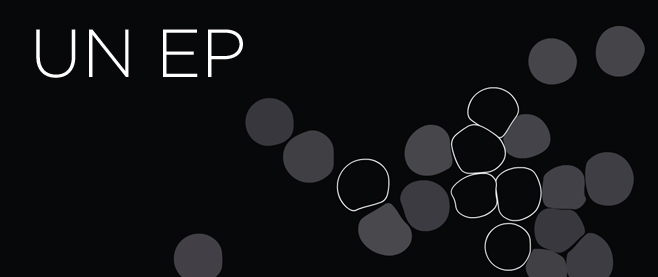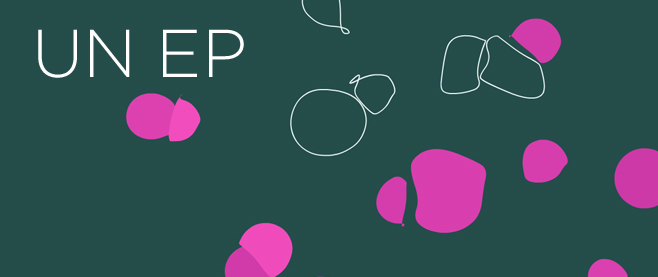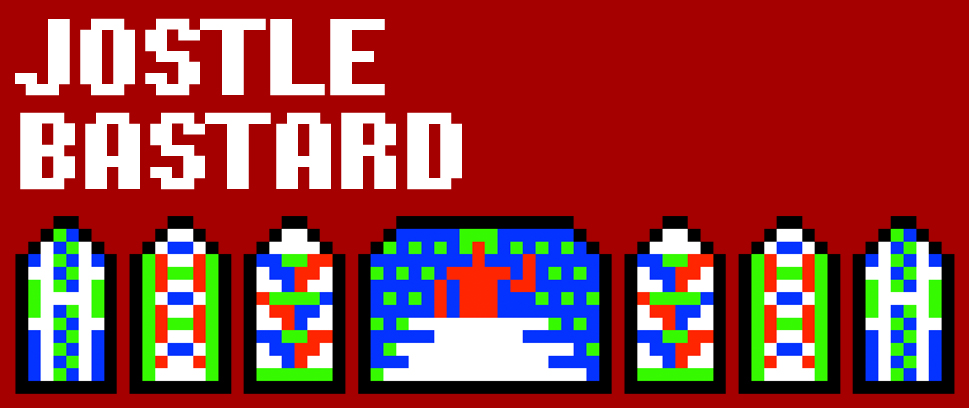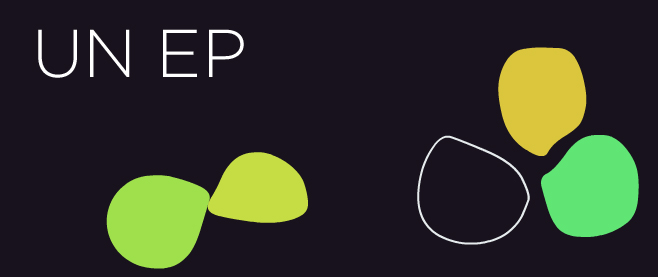
Exploring the Sights and Sounds of UN EP
If Playable is a dialogue for the many perspectives of games and the designers that make them, UN EP is an analogue for its fringe. Developer Ian Snyder’s experimental music tool – one could almost hesitate to call it a “game” in a traditional sense – gives the player leave to dive into a handful of disparate aural worlds, experimenting not only with improvisational composition but also aesthetics. You can, in a sense, let your creations breathe here, resulting in molded sound shapes meshed with visual topography of your own design (and interpretation).
But how did Ian come up with UN EP’s design, and what does it mean? Snyder’s answers may help illuminate the game’s imaginative, inscrutable face.

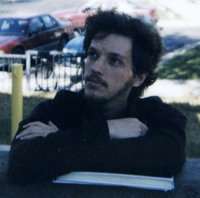 Unwinnable: How did you come up with the project?
Unwinnable: How did you come up with the project?
Ian Snyder: Are you familiar at all with a website called Super Friendship Club? It was this old forum I helped run with a bunch of other game developers. Every other month or so, we’d hold these monthlong game-making pageants, where we’d have a theme and everybody would make a game around it. For one pageant – the theme was “Universe” – I had the idea to create this series of music toys in the vein of Electroplankton. Each of these was this self-contained living, feeling organism type game. It’s a very vague idea, but each toy would be its own pocket universe that made pretty sounds. By the time the month had ended, though, I’d only made progress on UN EP’s toy “Verse,” so I put the project aside for a long time – I don’t know how long it was exactly. Then, slowly, whenever I had a small side experiment that I’d want to work on, just a little visual thing or maybe an audio thing – not necessarily something that led into the main development projects that I was working on – it would get filed into this ongoing UN EP project.
Unwinnable: Where does the name come from?
I.S.: Originally, it was a pun on the “Universe” pageant theme. Where Un begins – “UN/Verse” – was the original toy I made, with the slash being the “I.” Kind of stupid, but [chuckles]. And I’m going on that theme, where each of the little toys is meant to be taken as if the prefix “Un” would be attached to them. It was this idea that I picked up and ran with. Each of them can be read as “Unveil” or “Uncycle” or just “Cycle” or “Veil”.
Electroplankton is the most direct predecessor that I’m drawing inspiration from in regards to sound toys. I’ve always heard that game referred to as a bunch of sound toys, so that’s kind of the word I picked up on. If I were to give them a name myself I don’t know what I’d call them, exactly. “Toys” is just a convenient term that I use, but I don’t know. I guess I think of them as closer to art objects, as silly and pretentious as that sounds.
Unwinnable: How did your ideas for UN EP manifest themselves?
I.S.: A lot of the time I’m not sure. It’s often just a new programming technique that I would learn. Say, for example, I would learn how to draw things to a bitmap in Flash and that would provide new visual plateaus to explore that I’d been previously unable to achieve. None of these small explorations really fit into whatever major project I’m working on at the time but, nonetheless, they’re things that catch my eye.
There’s this point in developing procedural or toy-like things, where you go from building something to watching the thing you’ve built run and go do its thing. There’s kind of a hypnotic element when you learn a new programming technique and you’re just playing around with it. So most of these were just the results of playing around and finding these small ins and outs of whatever line of code I’d learned that had hypnotized me looking at them.
Unwinnable: So it was more of an organic process.
I.S.: Yeah, definitely. It really just came along as I felt it pushing me in any direction.
Unwinnable: How did you actually go about making the game? Was it just a matter of putting together these disparate blocks of code and setting it up to work?
I.S.: Sadly, it’s not very interesting. They were all separate files and I just mashed all into a single file in the end. And then jury-rigged them to be able to play in the same key. The menu – I felt it should be something musical and something people could play with and not necessarily something discrete or something that easily communicated that it was a menu. Which is why you get those weird dancing blobs.
 Unwinnable: Was the menu’s functionality just another example of something you happened to learn and wanted to put to use somewhere?
Unwinnable: Was the menu’s functionality just another example of something you happened to learn and wanted to put to use somewhere?
I.S.: Actually the menu was one case where that’s not true. The menu is made explicitly to serve as a menu. I guess it’s a manifestation of things I had known well before actually making it.
Unwinnable: Why did you want that particular aesthetic and feel to be the first thing people see when experiencing UN EP? It feels very alive and organic, very natural.
I.S.: I’m glad to hear you say that – that’s how I wanted it to feel. As I said earlier, the original idea was that each of these would feel like their own kind of organism or strange living thing. And so the menu in some ways is just a distillation of some of those ideas. I wanted it to feel like a living thing itself. In particular I was looking at small cells, or the way that plants grow into balls – like you know a raspberry is made up of all these tiny spheres that kind of smush into each other? I was interested in the way that these circles would interact and bend and crush each other and move around in space.
Unwinnable: The range of instruments you have in these various worlds – each of these use a different type of instrumentation. What was the thought process behind choosing which instruments you would use and where you would use them? Take “Form” – it sounds like a percussive instrument when you hit the 3D dodecahedron.
I.S.: “Form” is one where the timbre of the instruments was really important to me. And it’s more about how the sounds feel than necessarily making something melodic or pretty. But I’m particularly excited about how I made those sounds. The percussive hit that you’re referring to is actually – I took a paper clip and attached it to a harmonic spot of an acoustic guitar and just plucked it. And when you hear it, it sounds like this really deep kind of distant church bell. And some of that is lost when it’s recorded. It sounds like a much smaller bell being hit. But it’s still this really bizarre sound that I’m infatuated with.
Unwinnable: Did you use a similar DIY approach for the rest of the sounds in UN EP?
I.S.: In some places yes and in some places not quite. We can go spot by spot, talk about them individually.
The sounds in “Verse” are just little generated sine wave bells which I got from some tutorial example on the Internet about how to synthesize sounds in Flash that I don’t even remember. They work really well so I never got around to changing them. They just ended up sticking. There’s probably some messy copyright issues with them, I don’t know. But whatever.
For “Cycle,” it’s a set of piano notes that I think are from http://freesound.org that have been recorded using this method that involves placing felt on piano strings, I’m not sure exactly. I always meant to revisit Cycle and replace the sounds.
“Felt” is – I was messing around with just basic soundwaves in Flash. I built this tool where I could take a soundwave and physically mold it and hear the effect of changing its shape by molding it in real-time. I messed around with that until I found something that I liked. Then I took the envelope – the general shape that a note’s volume makes, the overall progression of volume as the note is played – from those piano notes in “Cycle” and applied it to the start of the synthesizer notes, then gave it a long tail. And all of these notes constantly play into each other. They never fade out. A global volume control makes sure everything is at a certain level. Beyond that they just average into each other instead of ever stopping. Unless you let the visuals stop.
“Veil” – I went through a lot of sounds for it and was difficult to score. It was one of the experiments that was more visual than it was aural at first. I guess there’s several parts to it. There’s the colored state, where it’s making lots of noise and the mouse is held down and there’s the upheld state, which is the weird fading drone kind of thing.
Originally, it didn’t have those two states. It started in this gray form and by turning [the on-screen image] it would slowly build it up to a big pillared thing. That didn’t feel like I wanted it to. It was too distant from the player. I’m much more satisfied with the current click [to on-screen action] where it expands and contracts, kind of like a jellyfish.
 Anyway, the sound. Originally I sampled some stuff from this David Kanaga track – the musician for Proteus – and just had that in there. And it played forward when you spun it forward and it reversed when you spun it in reverse. Then there was this middle sound that was more just a drone when neither of the other were playing. But those only reacted to the direction of the spin – they didn’t have anything to do with the speed or whether the mouse was held down, it wasn’t really about the player’s interaction with it yet. It was just this thing you scrubbed back and forth on.
Anyway, the sound. Originally I sampled some stuff from this David Kanaga track – the musician for Proteus – and just had that in there. And it played forward when you spun it forward and it reversed when you spun it in reverse. Then there was this middle sound that was more just a drone when neither of the other were playing. But those only reacted to the direction of the spin – they didn’t have anything to do with the speed or whether the mouse was held down, it wasn’t really about the player’s interaction with it yet. It was just this thing you scrubbed back and forth on.
I stripped that out and replaced it with a drone of my own construction that swells when it’s moving faster and changes when you reverse it. The little plink-plink sounds that you hear, which are just guitar harmonics on an electric guitar, happen every time a certain diameter of the circle makes a complete revolution. They scale whether it’s going faster or slower. And I think they change keys based on which direction you’re rotating.
And for those who want to know what’s going on in the colored state: when you hold the mouse down it expands into the colored state and when you release the mouse it drops back down into the black and white. When it expands, it’s kind of like mixing water around in a pot, that’s the level of interactivity you get.
Unwinnable: How did you come up with what the sounds were going to do versus what the player was doing in-game?
I.S.: There’s this really nice symmetricality between playing instruments and playing games. I mean, they use the same word, right? Play. It’s what we do when we make music, we play. When we play games, we play. There’s this interesting space between those because the goal of play in each is maybe not the same thing. With games, we usually think we’re playing to a certain end, whereas with music, it can be improvisational. There’s more freedom and it’s more about how you play rather than just playing to get to an end at all. It’d be absurd to say you won a piece of music in the same way you can win a game.
I’m interested in musical play and gameplay and the interaction of the two. The improvisational play in terms of games is something that I’m fascinated by. And that’s what I want to get at with this project – the idea that play in a digital space can occur toward the end of, say, aesthetic pleasure. Not necessarily as a means to achieve something like a score or a cutscene or what have you. It’s the same kind of idea approached by games like Proteus or Panoramical. But where Proteus is tied to exploring this physical location and it’s still deeply rooted in the language of videogames, UN EP divorces itself from the notion of navigating through a representational environmental. I still think one is navigating through a kind of space in UN EP, but the space that one navigates through is abstract and it is a space that’s made up of state changes rather than physical location.
Unwinnable: What’s interesting in games and music as two different mediums?
I.S.: I guess they’re just two mediums that have been with me all of my life. Or at least I discovered them around the same time, which would’ve been late middle school/early high school, where I began making games and writing music at the same time. And I’ve always wanted to bring the two together into a single project. This game is a way of giving a player a chance to not only play a game but also experience beauty and play music at the same time.
Unwinnable: Are you more of a musician or a game designer?
I.S.: More of a game designer, definitely. I’m not a very good musician, to be honest. [laughs] I’ve always been a lot more comfortable writing a program to write music for me than I am writing music. I guess the form of the computer and interacting with computers is something that’s more immediately familiar to me and has come to the point where I can express myself with code rapidly enough that the time from the idea of a piece I want to make to the creation of the actual piece is minimal. Whereas with music, it’s two different kinds of mastery. There’s mastery of music and then there’s mastery of programming. And I guess I’ve just grown more on the programming side than I have the instrument-playing side. Because it’s still difficult to rapidly find a musical idea on an instrument and create it. Or play it, I guess.
Unwinnable: One last thing: what’s with the multiplayer?
I.S.: The multiplayer element of UN EP – it’s a silly pun, as I guess a lot of this project has arisen from. The game itself doesn’t allow for multiple players – multiplayer mode is just something that switches all of the toys to the same key. So, if you got a friend to also boot up the game on their computer and turn on multiplayer mode, the two of you could play these sound toys together at once and they would be in relative harmony to each other. It’s multiplayer in the sense that playing in a band is multiplayer.
It’s one of the elements that’s weirdest about the game that I want to develop further and in other game projects. It feels like it’s just on the edge of a fully-formed idea, like this is a really good way to get at the idea of games that are not networked to each other via any network connection but by the players themselves. So, if you were to play this with a friend, the only reason that it would be multiplayer is because you can hear the sounds that they’re making and they can hear the sounds that you’re making. And the two of you recognize that these sounds fit together in some sense. It’s networked on the human mind rather than an Internet connection or a LAN connection or something.
———
You can play UN EP here. For more on UN EP, read Ken Lucas’ interview with Ian Snyder on the musical aspects of the game. Finally, check out the addendum to listen to the ambient songs Ken recorded using UN EP and see UN EP production art.
Ian Snyder’s Twitter compositions can be found @whatisian and you can explore more of his work on his website. Find Steve Haske @afraidtomerge.


